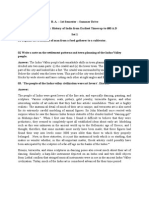Elements of Civilization
Elements of Civilization
Uploaded by
MARIA CASTELLANOSCopyright:
Available Formats
Elements of Civilization
Elements of Civilization
Uploaded by
MARIA CASTELLANOSCopyright
Available Formats
Share this document
Did you find this document useful?
Is this content inappropriate?
Copyright:
Available Formats
Elements of Civilization
Elements of Civilization
Uploaded by
MARIA CASTELLANOSCopyright:
Available Formats
Name________________________________________
The Characteristics Important to Civilizations
After the Neolithic Revolution, villages began to form. Over thousands of years, the populations of
these villages began to grow. Eventually, some of these villages became cities. These cities required
a higher level of organization than villages. The leaders established complex, centralized
governments in order to achieve this. Since the government had many tasks to perform, a
bureaucracy was set up. While there was usually a single ruler, many people worked for the rulers as
part of this bureaucracy.
As people took on different roles in society, a division of labor, or job specialization, occurred. Instead
of everyone working to provide his or her own basic needs, different people learned and performed
different tasks. This made people interdependent (they relied on each other.) However, this also led to
the development of social classes. Certain jobs were considered to hold a higher status than others.
Those who worked as part of the government bureaucracy were usually considered nobles, or a higher
status, than farmers and other workers, known as peasants.
The forces of nature played a very important role in the lives of these people. The survival of the city
depended on good production of crops. Droughts, floods, or storms could all destroy a harvest and
doom everyone. Beliefs often developed that there were gods who controlled these forces and rituals
and ceremonies honoring these gods would ensure good conditions. Temples were built where priests
performed these ceremonies. Everyone in the city was expected to participate. This is the
development of organized religion. Because of their importance, priests gained a high status in
society. Very often, the ruler of the government was also the high priest.
These temples are one example of public works constructed by the government. Public works are
buildings and facilities designed for the benefit and use of the general population. Temples,
government buildings, public baths and marketplaces are all examples of public works. They allowed
the daily activities of a large populated city to go on.
In order to build these large structures, architectural skills were developed. People in different regions
of the world often developed distinct architectural styles. Public works were often decorated with art.
Paintings, sculptures, and carvings often illustrated the daily life and the beliefs of the people. In these
ways, art and architecture were important parts of city life. While artisans were skilled at their craft,
there were usually peasants, the lower social class.
As life became more complex, it became necessary to develop a method for keeping records.
Government laws and religious ceremonies needed to be recorded. Rulers often wanted to leave a
record of their accomplishments. Writing systems were developed for these purposes. Early writing
systems usually consisted of pictograms (picture symbols). This allowed information to be passed from
generation to generation. A new generation could then build upon the knowledge of each previous
generation.
Each of these characteristics became an important part of the development of modern
civilization.
You might also like
- ULRICH BECK: Risk Society - Sociedade Do Risco.Document3 pagesULRICH BECK: Risk Society - Sociedade Do Risco.Nuno MornaNo ratings yet
- Civilization NotesDocument2 pagesCivilization Notesbskk6nczhrNo ratings yet
- 8 Features CivilizationDocument1 page8 Features Civilizationmuftizaman100% (1)
- History of India From Earliest Times Up To 600 A.D.Document14 pagesHistory of India From Earliest Times Up To 600 A.D.nupurNo ratings yet
- Introduction To Human Settlements - Brief DescriptionDocument3 pagesIntroduction To Human Settlements - Brief DescriptionLavanya Jothi VenkatachalamNo ratings yet
- Public Administration Unit-89 Evolution and Role of Panchayati RajDocument9 pagesPublic Administration Unit-89 Evolution and Role of Panchayati RajDeepika SharmaNo ratings yet
- MesopotamiaDocument5 pagesMesopotamiaanuroopmishra10bNo ratings yet
- SW Education and Training in IndiaDocument12 pagesSW Education and Training in IndiaApoorva SudhirNo ratings yet
- 09 - Chapter 2Document54 pages09 - Chapter 2anashwara.pillaiNo ratings yet
- 01.05 Travel Journal: Some Settlements Became The First Cities, Called River Valley CivilizationsDocument1 page01.05 Travel Journal: Some Settlements Became The First Cities, Called River Valley CivilizationsSagabiNo ratings yet
- History of Community OrganizationDocument17 pagesHistory of Community OrganizationScribdTranslationsNo ratings yet
- Processes That Led To Early UrbanizationDocument6 pagesProcesses That Led To Early UrbanizationPatrick Solomon NizahNo ratings yet
- Islamic Civilization and CultureDocument16 pagesIslamic Civilization and CultureShan Ali ShahNo ratings yet
- Essay - The Origin of CivilizationDocument4 pagesEssay - The Origin of CivilizationAmanda HawkerNo ratings yet
- Social, Political, and Cultural Development of Man: A New Social OrderDocument3 pagesSocial, Political, and Cultural Development of Man: A New Social Orderfrancisse maryvil faustinoNo ratings yet
- Rural JournalismDocument14 pagesRural JournalismSiddharth SharmaNo ratings yet
- A Civilization Is A Complex Society That Creates ADocument27 pagesA Civilization Is A Complex Society That Creates Adr7dh8c2sdNo ratings yet
- Characteristics of Civilizations ActivityDocument4 pagesCharacteristics of Civilizations Activitygoughje1No ratings yet
- The Seven Characteristics of CivilizationDocument17 pagesThe Seven Characteristics of Civilizationapi-269480354No ratings yet
- History of Social WorkDocument137 pagesHistory of Social WorkPriyabrataMishraNo ratings yet
- 6-Culture and CivilizationDocument41 pages6-Culture and CivilizationmubashirNo ratings yet
- Power Point Presentation On Sociology Rural-Urban DichotomyDocument17 pagesPower Point Presentation On Sociology Rural-Urban DichotomyAashana AgarwalNo ratings yet
- Social Change and Social Order Notes Class 11Document6 pagesSocial Change and Social Order Notes Class 11vedaketshahaNo ratings yet
- Nafi Interfaith BridgebuildingDocument9 pagesNafi Interfaith BridgebuildingmineasaroeunNo ratings yet
- Unit Local Government in India: 2 SelfDocument23 pagesUnit Local Government in India: 2 SelfAgniswar GhoshNo ratings yet
- Caste, Class, and Power: Changing Patterns of Stratification in a Tanjore VillageFrom EverandCaste, Class, and Power: Changing Patterns of Stratification in a Tanjore VillageNo ratings yet
- Teacher Willyn Jean C. Apostol: Humanities and Social Scien Ces Grade 12Document51 pagesTeacher Willyn Jean C. Apostol: Humanities and Social Scien Ces Grade 12カ タ100% (2)
- Murray Happiness1615 LFPDF PDFDocument328 pagesMurray Happiness1615 LFPDF PDFjasonNo ratings yet
- Panchayat RajDocument33 pagesPanchayat RajSurabhi Sadavat100% (1)
- Local Self GovernmentDocument51 pagesLocal Self Governmentprathameshinamdar55No ratings yet
- LSG Unit 1Document12 pagesLSG Unit 1smritig1199No ratings yet
- Chapter - Ii Origin and Growth of GramsabhaDocument34 pagesChapter - Ii Origin and Growth of GramsabhaAnjaliNo ratings yet
- Eastern Star Academy, Inc. Senior High School Department: Pre-TestDocument7 pagesEastern Star Academy, Inc. Senior High School Department: Pre-TestJhener NonesaNo ratings yet
- Industrial City Is A Planned City: Arpana RoyDocument11 pagesIndustrial City Is A Planned City: Arpana Royarpanaroy1No ratings yet
- His 102-Project Report Title: A Brief Report On Mesopotamian CivilizationDocument8 pagesHis 102-Project Report Title: A Brief Report On Mesopotamian CivilizationShakil AhmedNo ratings yet
- Religion's Contribution To Civilization-1Document12 pagesReligion's Contribution To Civilization-1Kaung Myat ThuNo ratings yet
- Unit 7 Cities and Urban Land UseDocument106 pagesUnit 7 Cities and Urban Land UseAlex SanchezNo ratings yet
- 4.4 Rural Society Change and ContinuityDocument15 pages4.4 Rural Society Change and ContinuityKumar Deepak100% (1)
- Bed 1104Document2 pagesBed 1104john mwangiNo ratings yet
- Continuity and Change NotesDocument25 pagesContinuity and Change NotesSatvik SiddhantNo ratings yet
- Processes of Social Change in Indian SocietyDocument8 pagesProcesses of Social Change in Indian SocietymdanisurambiaNo ratings yet
- Early Civilization and The Rise of StateDocument11 pagesEarly Civilization and The Rise of StateAiz 21No ratings yet
- Neha - Civilization of The WorldDocument80 pagesNeha - Civilization of The WorldkaliNo ratings yet
- Changes in Indian VillagesDocument27 pagesChanges in Indian VillagesNitin Bhamare33% (3)
- 06.chapter 1Document29 pages06.chapter 1J Private100% (1)
- 15 Organisational Structure of Urban Local BodiesDocument22 pages15 Organisational Structure of Urban Local BodiesInvincible BaluNo ratings yet
- Social WorkDocument95 pagesSocial WorkNaveen Kumar100% (2)
- Social Change in The North East-Pdf - 231030 - 194318Document4 pagesSocial Change in The North East-Pdf - 231030 - 194318lalookitbok47No ratings yet
- Notes LSGDocument85 pagesNotes LSGPranshuNo ratings yet
- Studi Hubungan Ruralisasi Dengan Penduduk Lokal: Pola Kerukunan Hidup Umat Beragama Di Daerah Pinggiran JakartaDocument16 pagesStudi Hubungan Ruralisasi Dengan Penduduk Lokal: Pola Kerukunan Hidup Umat Beragama Di Daerah Pinggiran Jakartapaklek joNo ratings yet
- HW Notes Template ExampleDocument2 pagesHW Notes Template ExampletherealmccoymthebronNo ratings yet
- Social Work Profession Notes - FullDocument109 pagesSocial Work Profession Notes - FullEbenezar Paul Ratnaraj SNo ratings yet
- 8 Common Factors of CivilizationDocument14 pages8 Common Factors of CivilizationDerek EggenNo ratings yet
- Desa Adat Atau Desa Administratif Konte PDFDocument15 pagesDesa Adat Atau Desa Administratif Konte PDFSetyo NugrohoNo ratings yet
- E Portfolio Signature Assignment 2Document3 pagesE Portfolio Signature Assignment 2api-438756082No ratings yet
- Inovasi Sdes WisataDocument9 pagesInovasi Sdes WisataMery DharmayantiNo ratings yet
- Reflection Paper: Lupa and President's Office ExhibitDocument2 pagesReflection Paper: Lupa and President's Office ExhibitNathalie DagmangNo ratings yet
- The Role of Religion in Shaping CivilizationDocument2 pagesThe Role of Religion in Shaping CivilizationShahriar RupamNo ratings yet
- Citizenship and Governance in a Changing City: Somerville, MAFrom EverandCitizenship and Governance in a Changing City: Somerville, MANo ratings yet
- Sony Hcd-gx45 Rg440 Ver-1.2Document78 pagesSony Hcd-gx45 Rg440 Ver-1.2Mario GalvezNo ratings yet
- Armitage1995 - Methods AR PDFDocument28 pagesArmitage1995 - Methods AR PDFNicolas CopernicNo ratings yet
- Quiz Exercises 9 Reported Speech 9Document2 pagesQuiz Exercises 9 Reported Speech 9Joséphine NancasseNo ratings yet
- Electromagnetic Compatibility by Felicito S Caluyo PDFDocument40 pagesElectromagnetic Compatibility by Felicito S Caluyo PDFmjpadz100% (2)
- Recent Applications of Phased Array Inspection For Turbine Components and Welded StructuresDocument8 pagesRecent Applications of Phased Array Inspection For Turbine Components and Welded Structureskoohestani_afshinNo ratings yet
- KKN - Mine Warfare OperationsDocument3 pagesKKN - Mine Warfare OperationsMegat AshlanNo ratings yet
- Surface Diagnostics in TribologyDocument13 pagesSurface Diagnostics in TribologyDersein SaraozNo ratings yet
- Menumbuhkan Minat Baca Masyarakat Melalui Taman Bacaan Masyarakat Berbasis Teknologi InformasiDocument12 pagesMenumbuhkan Minat Baca Masyarakat Melalui Taman Bacaan Masyarakat Berbasis Teknologi InformasiDani TrashNo ratings yet
- Mean Value Formula For Heat Equation 2Document11 pagesMean Value Formula For Heat Equation 2sahlewel weldemichaelNo ratings yet
- Data Sheet - Cyber Investigator Nse21Document5 pagesData Sheet - Cyber Investigator Nse21James WangNo ratings yet
- 004 Profitability of Islamic BankDocument18 pages004 Profitability of Islamic BanksaraNo ratings yet
- Unikrn Bermuda LTD Terms of Token Sale Last Updated: September 22, 2017Document20 pagesUnikrn Bermuda LTD Terms of Token Sale Last Updated: September 22, 2017Rony PatahNo ratings yet
- Eagle Syndrome An Unusual Cause of Head and Neck PainDocument2 pagesEagle Syndrome An Unusual Cause of Head and Neck PainCecilia AnderssonNo ratings yet
- The Hive BOT Meeting August 2022Document56 pagesThe Hive BOT Meeting August 2022Michael MendozaNo ratings yet
- PDS BlankDocument13 pagesPDS BlankDarryl RegaspiNo ratings yet
- Surpresa para Ni KikoDocument20 pagesSurpresa para Ni KikoLara Montera100% (1)
- Standard Costing, Operational Performance Measures, and The Balanced Scorecard (SoftCopy - Solman)Document40 pagesStandard Costing, Operational Performance Measures, and The Balanced Scorecard (SoftCopy - Solman)Hannah Grace JustoNo ratings yet
- B9ed0measures of Central TendencyDocument36 pagesB9ed0measures of Central TendencyGeetanshi AgarwalNo ratings yet
- DvdavkjkDocument82 pagesDvdavkjkNajeebuddin AhmedNo ratings yet
- ZyEl 4.5Document42 pagesZyEl 4.5Dan PNo ratings yet
- Lceture 1 Course InformationDocument21 pagesLceture 1 Course InformationBakyt SmagulovaNo ratings yet
- Ref. No. 257, S. 2019 - Submission of Participants To The Division Teacher Induction Program (TIP) 2019 PDFDocument17 pagesRef. No. 257, S. 2019 - Submission of Participants To The Division Teacher Induction Program (TIP) 2019 PDFChristine SalientesNo ratings yet
- PhysicsDocument2 pagesPhysicsSuyash DixitNo ratings yet
- Fire Safety Easy Quiz - BrainPOP JRDocument1 pageFire Safety Easy Quiz - BrainPOP JRleduylamNo ratings yet
- PresentationsDocument1 pagePresentationsMadina SaparbaevaNo ratings yet
- Trichomonas Vaginalis: Frothy DischargeDocument9 pagesTrichomonas Vaginalis: Frothy DischargeeurocoupeNo ratings yet
- GRFN Company ProfileDocument17 pagesGRFN Company Profileenergy8001No ratings yet
- Flipping The Classroom Its Influence On Student Engagement 2 2Document31 pagesFlipping The Classroom Its Influence On Student Engagement 2 2Mr. BatesNo ratings yet
- Determining The Scope of The Quality Management SystemDocument6 pagesDetermining The Scope of The Quality Management SystemNaeemNo ratings yet
























































































